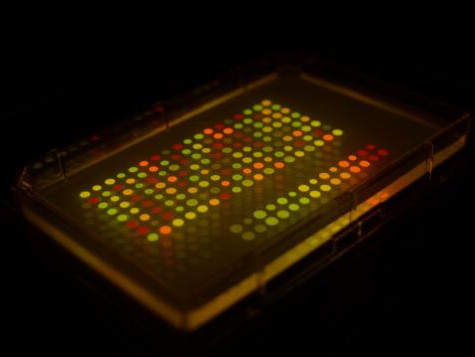
研究人员发明了一种新型密码,利用细菌传递机密信息,这种细菌会在特定条件下发光。除了用于间谍活动外,这项技术可以让企业给农作物、种子,或其它有生命的物品编码秘密的身份信息。美国国防部高级研究计划署(DARPA)几年前邀请研究人员提出不需要电的秘密信息编码的方法。麻省塔夫斯大学的化学家David Walt和同事考虑使用细菌。
他们利用7个大肠杆菌菌株群,每个都加入了能表达出不同颜色荧光蛋白的基因。当基因打开后细菌就会发出不同颜色的光,如红绿蓝,人眼可以清晰识别出这些光。研究人员随后利用颜色组合信息。7种颜色有49种组合,可用于编码26个字母和23个字母数字符号如@和$。
之后可以简单的根据细菌排列写入和读取信息。为了打印信息,细菌被转移到发光媒介,被印在硝化纤维纸片上。但纸上的细菌并不会发光,信息接受者还需要用化学药剂打开关键的基因激活荧光蛋白表达。
研究人员还加入了更严格的安全机制,给部分细菌植入了抵抗特定抗生素的基因,只有能耐抗生素的细菌才携带真正的机密信息。因此一旦信息落入错误人手中,他们将无法读取出机密信息。只有解码者加入了正确的抗生素之后,不能耐抗生素的细菌死亡,才会留下真正有用的信息。化学家 Kenneth Suslick说,这真是一个很酷的点子。
相关研究结果发表在最新《PNAS》在线杂志上。《Science》和《Nature》杂志都在第一时间报道了这一进展。
生物探索推荐英文论文原文摘要:
InfoBiology by printed arrays of microorganism colonies for timed and on-demand release of messages
This paper presents a proof-of-principle method, called InfoBiology, to write and encode data using arrays of genetically engineered strains of Escherichia coli with fluorescent proteins (FPs) as phenotypic markers. In InfoBiology, we encode, send, and release information using living organisms as carriers of data. Genetically engineered systems offer exquisite control of both genotype and phenotype. Living systems also offer the possibility for timed release of information as phenotypic features can take hours or days to develop. We use growth media and chemically induced gene expression as cipher keys or “biociphers” to develop encoded messages. The messages, called Steganography by Printed Arrays of Microbes (SPAM), consist of a matrix of spots generated by seven strains of E. coli, with each strain expressing a different FP. The coding scheme for these arrays relies on strings of paired, septenary digits, where each pair represents an alphanumeric character. In addition, the photophysical properties of the FPs offer another method for ciphering messages. Unique combinations of excited and emitted wavelengths generate distinct fluorescent patterns from the Steganography by Printed Arrays of Microbes (SPAM). This paper shows a new form of steganography based on information from engineered living systems. The combination of bio- and “photociphers” along with controlled timed-release exemplify the capabilities of InfoBiology, which could enable biometrics, communication through compromised channels, easy-to-read barcoding of biological products, or provide a deterrent to counterfeiting.







